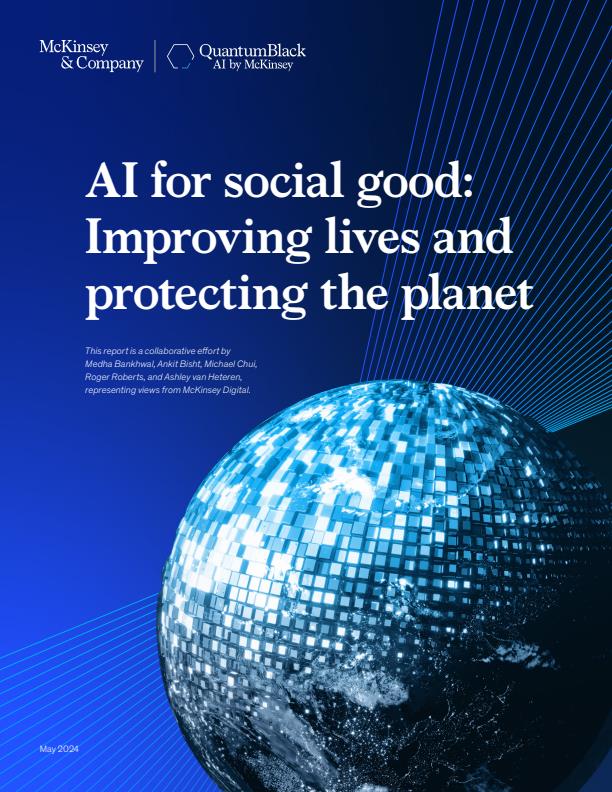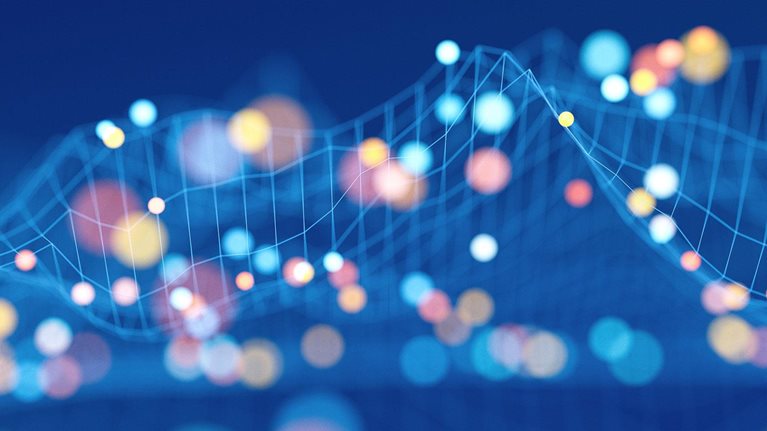Advances in AI have accelerated dramatically over the past two years, marked by an ability to design, train, and—most important—run AI at a large scale and for many millions of users. AI’s potential impact spans sectors and could deliver positive social change.
In fact, AI is already being used to further all 17 UN Sustainable Development Goals (SDGs)—from the goal of eliminating poverty to establishing sustainable cities and communities and providing quality education for all. Generative AI has opened even more possibilities. In 2018, it was becoming clear that AI could play a major role globally in promoting not only productivity and economic growth but also social good. A report we published at the time outlined how AI capabilities, from natural language processing to sound recognition and tracking, could be used in 170 use cases to benefit society1—including to promote equality and inclusion, improve crisis response, and protect the environment.2 Today, we have discovered a total of about 600 use cases, more than a threefold increase.3
In our 2024 report, we take another look at how AI can and has already become a key part of solutions to benefit people and the planet by mapping innovations and impact to the SDGs (see sidebar “Methodology”). The SDGs comprise 17 goals and 169 targets that aim to improve lives around the world and protect the planet. But the 2023 UN update on progress against the SDGs indicated that the world is on track to meet only 15 percent of SDG targets.4 In real terms, this means that today, 2.2 billion people lack access to safe water and hygiene; 3.5 billion lack access to safely managed sanitation5; roughly 3.3 billion live in environments highly vulnerable to climate change6; and 750 million are facing hunger.7
AI’s potential across the SDGs and how funding for AI supports progress
While AI will affect all SDGs, experts we surveyed believe that AI has a particularly high potential to make a difference for five: Good Health and Well-Being (SDG 3), Quality Education (SDG 4), Climate Action (SDG 13), Affordable and Clean Energy (SDG 7), and Sustainable Cities and Communities (SDG 11). In fact, 60 percent of deployments of not-for-profit AI for social good were in these areas. Relative to their perceived AI-potential, the SDGs for Zero Hunger (SDG 2), Life on Land (SDG 15), and Peace, Justice and Strong Institutions (SDG 16) have many use case deployments, whereas Quality Education (SDG 4), Affordable and Clean Energy (SDG 7), and Climate Action (SDG 13) have fewer (Exhibit 1). We excluded Decent Work & Economic Growth (SDG 8); Industry, Innovation & Infrastructure (SDG 9); and Partnerships for Goals (SDG 17) from the not-for-profit deployment, foundation grants, and private capital analysis. This is because most projects can be tagged to these areas given the broad AI applicability.8

In analyzing where funding has been deployed toward harnessing AI for the SDGs, we see directional alignment with the experts’ opinion of the five highest-potential areas. The combined view of grant and private capital funding centers on Good Health and Well-Being (SDG 3), Quality Education (SDG 4), Affordable and Clean Energy (SDG 7), Sustainable Cities and Communities (SDG 11), and Climate Action (SDG 13). In addition, about 40 percent of private capital investments into the 20,000 AI companies analyzed contributed directly or indirectly toward at least one of the 17 SDG thematic areas.9
There are, however, exciting pockets of opportunity. Consider the relatively low private capital funding for Quality Education (SDG 4). Even for Affordable and Clean Energy (SDG 7) and Climate Action (SDG 13), more than 50 percent of the private capital investment went toward autonomous vehicles for improving energy efficiency and reducing emissions. This suggests further potential for private entities to deploy capital toward SDG themes where AI has high potential.
Geographic disparities in grant allocation remain high. An analysis of the location of grant recipients’ headquarters from a database of US-majority foundations reveals that, from 2018 to 2023, only 10 percent of grants allocated toward AI initiatives that address one or more of the SDGs went to organizations based in low or middle-income countries.10 While organizations may have impact outside of the countries where they are headquartered, 60 percent of experts responding to our survey11 agreed that AI efforts today are not focused enough on benefiting lower-income countries (as opposed to higher income or developed countries), where the need and SDG impact can be the highest.
Challenges and risks of scaling AI for social good
Challenges in scaling AI for social-good initiatives are persistent and tough. Seventy-two percent of the respondents to our expert survey observed that most efforts to deploy AI for social good to date have focused on research and innovation rather than adoption and scaling. Fifty-five percent of grants for AI research and deployment across the SDGs are $250,000 or smaller, which is consistent with a focus on targeted research or smaller-scale deployment, rather than large-scale expansion. Aside from funding, the biggest barriers to scaling AI continue to be data availability, accessibility, and quality; AI talent availability and accessibility; organizational receptiveness; and change management. More on these topics can be found in the full report.
While overcoming these challenges, organizations should also be aware of strategies to address the range of risks, including inaccurate outputs, biases embedded in the underlying training data, the potential for large-scale misinformation, and malicious influence on politics and personal well-being.12 As we have noted in multiple recent articles,13 AI tools and techniques can be misused, even if the tools were originally designed for social good. Experts identified the top risks as impaired fairness, malicious use, and privacy and security concerns, followed by explainability (Exhibit 2).14 Respondents from not-for-profits expressed relatively more concern about misinformation, talent issues such as job displacement, and effects of AI on economic stability compared with their counterparts at for-profits, who were more often concerned with IP infringement.

Accelerating the deployment of AI for social good
Scientific breakthroughs have increased the effectiveness of AI at pattern recognition, prediction, and creation. This progress has coincided with a rapidly growing number of successful AI deployments, but, as we saw above, there are still challenges to scaling their use for addressing the SDGs. Realizing this potential will require stakeholders to collaborate more closely to ensure access to adequate talent and robust data solutions, as well as to AI applications and models that are more open-sourced or scalable across user geographies around the world, thereby meeting people at the point of need.
By collaborating to find ways to put AI to work at scale for social good, mission-driven organizations, governments, foundations, universities, ecosystems of developers, and businesses can help solve some of the world’s most challenging and intractable problems. They can help thwart human trafficking, ensure girls and children all over the world receive the education they deserve, protect forests from illegal deforestation, support the health and safety of pregnant women and newborns, and so much more. If these things aren’t worth fighting for, what is?



